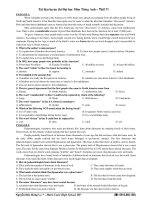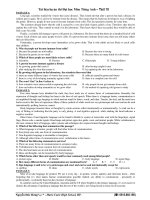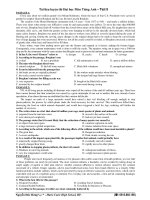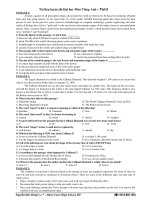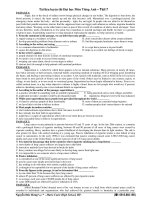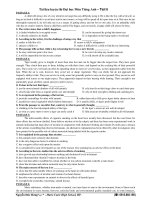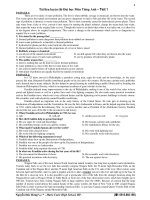Tµi liÖu luyÖn thi §¹i häc M«n TiÕng Anh – Test 10 doc
Bạn đang xem bản rút gọn của tài liệu. Xem và tải ngay bản đầy đủ của tài liệu tại đây (68.48 KB, 3 trang )
Nguyễn Đức Hưng** - Marie Curie High School, HP. (: 0912.883.190)
Tµi liÖu luyÖn thi §¹i häc M«n TiÕng Anh – Test 10
PASSAGE 1:
Long ago, scientists studied the viruses that cause diseases. They found out that after a person has had a disease, he
seldom gets it again. He is said to be immune from the disease. This means that his body has developed a way of fighting
the germs. However, people do not seem to become immune from colds. This fact puzzled scientists for some time.
The scientists already knew that the cold is caused by a very tiny kind of germ called a virus. Therefore, they tried to
capture the cold virus. They wanted to study it in the laboratory. They knew that if they succeeded, they would be able to
find a cure for colds.
Finally, a scientist did manage to grow cold germs in a laboratory. He discovered that there are a hundred kind of cold
viruses. Each of them can cause people to have colds. If a person becomes immune from some, there are still many others
that can infect him.
Fortunately, a person develops more immunities as he grows older. That is why adults are less likely to catch colds
than children.
1) Why do people not become immune from colds?
A. Because the people are not healthy B. Because the virus is strong
C. Because the germs are too small D. Because there are many kinds of cold viruses
2) Which of these people are most likely to have colds?
A. Scientists B. Doctors C. Old people D. Young children
3) A person becomes immune against a disease
A. by growing germs that cause it B. after having caught it once
C. after studying the virus that causes it D. by capturing the virus in the laboratory
4) By growing cold germs in the laboratory, the scientists discovered that
A. there are many different types of viruses that cause colds B. colds are caused by germs and viruses
C. there is a way of developing immunity against colds D. there is a complete cure for cold
5) The word “fact” in line 4 refers to
A. how scientists were unsuccessful in capturing the cold virus B. why people do not get immune from colds
C. how our bodies develop immunities as we grow older D. the method of capturing cold germs to study
PASSAGE 2:
Ever since humans have inhabited the earth, they have made use of various forms of communication. Generally, this
expression of thoughts and feelings has been in the form of oral speech. When there is a language barrier, communication is
accomplished through sign language in which motions stand for letters, words, and ideas. Tourists, the deaf, and the mute have
had to resort to this form of expression. Many of these symbols of whole words are very picturesque and exact and can be used
internationally; spelling, however, cannot.
Body language transmits ideas or thoughts by certain actions, either intentionally or unintentionally. A wink can be a
way of flirting or indicating that the party is only joking. A nod signifies approval, while shaking the head indicates a
negative reaction.
Other forms of non-linguistic language can be found in Braille (a system of raised dots read with the fingertips), signal
flags, Morse code, a smoke signals. Road maps and picture signs also guide, warn. and instruct people. While verbalisation is
the most common form of language, other systems and techniques also express human thoughts and feelings.
1) Which of the following best summarises this passage?
A. When language is a barrier, people will find other forms of communication.
B. Everybody uses only one form of communication.
C. Non-linguistic language is invaluable to foreigners.
D. Although other forms of communication exist, verbalisation is the fastest.
2) Which of the following statements is not true?
A. There are many forms of communication in existence today.
B. Verbalisation is the most common form of communication.
C. The deaf and mute use an oral form of communication.
D. Ideas and thoughts can be transmitted by body language.
3) Which forms other than oral speech would be most commonly used among blind people?
A. picture signs. B. Braille C. body language D. signal flags.
4) How many different forms of communication are mentioned here? A. 5 B. 7 C. 9 D. 11
5) Sign language is said to be very picturesque and exact and can be used internationally except for
A. spelling B. ideas C. whole words D. expressions
PASSAGE 3:
Most of us take language for granted. We use it every day - in spoken, written, auditory and electronic forms - while
forgetting that it’s what makes human communication possible. Indeed, our ability to communicate - personally or
professionally - is primarily based on the existence of language.
In countries such as the United Kingdom, Australia and the US where English is the primary language, it’s even easier to
dismiss the advantage of speaking a language that the rest of the world is now being forced to learn out of necessity.
Nguyễn Đức Hưng** - Marie Curie High School, HP. (: 0912.883.190)
More than two-thirds of the world’s population still does not use English. Yet, as the need to communicate globally
increases, English is fast becoming the number 1 choice for cross-border communication world-wide.
While increasing the ease of communication across borders, choosing a single global language also puts enormous
pressure on those who do not speak the chosen language. Encouraging one particular tongue as a primary or secondary
mode of communication in all countries also requires a serious commitment, along with extensive resources and funding.
This issue also raises critical questions around the importance of global intelligibility versus a country’s identity, as there
is no more sensitive symbol of individual and national identity than one’s language.
1) According to the passage, what makes human communication possible?
A. human’s ability to communicate B. language
C. human’s love for each other D. human’s professions
2) Why is it easier for the Australian, the Americans and the British to take English for granted?
A. Because they don’t like English. B. Because they are not forced to learn English.
C. Because they still live well without speaking English.
D. Because they were born with English as their primary language and they do not consciously realise its importance.
3) Based on the passage above, how many people use English world-wide?
A. one-third of the world’s population B. two-thirds of the world’s population
C. half of the world’s population D. 1.5 million people
4) Why is English becoming the number one language?
A. Because it is the simplest language in the world.
B. Because it is the language of the richest country in the world – the USA.
C. Because English has long been used by many people.
D. Because the need for communication across borderline increases.
5) Why should we be careful about choosing one particular language for all countries?
A. Because it takes a lot of time for all people in the world to learn a certain language.
B. Because all nations want to make their mother tongues the international language.
C. Because it may negatively affect an individual country’s national identity.
D. Because it’s hard to correct the mistake once you have already chosen the wrong language.
PASSAGE 4:
The White House, the official home of the United States president, was not built in time for George Washington to
live in it. It was begun in 1792 and was ready for its first habitants, President and Mrs. John Adams, who moved in on
November 1, 1800. When the Adamses moved in, the White House was not yet complete, and the Adamses suffered many
conveniences; for examples, the main staircase was incomplete, which hindered movement from floor to floor, and the
future laundry yard was merely a pool of mud, so wet laundry was hung in the unfinished East Room to dry. Thomas
Jefferson, the third president, improved the comfort of the White House in many respects and added new architectural
features such as the terraces on the east and west ends.
When the British forces burned the White House on August 24, 1814, President Madison was forced to leave. All that
remained after the fire was the exterior walls; the interior was completely destroyed. It was not until December of 1817
that the following president, James Monroe, was able to move into a rebuilt residence. Since then, the White House has
continued to be modified but has been continuously occupied by each succeeding U.S. president.
1) Which of the following would be the most appropriate title for this passage?
A. George Washington’s Life in the White House B. The Burning of the White House
C. The Early History of the White House D. Presidential Policies of Early U.S. Presidents
2) The word “inhabitants” in line 2 is closest in meaning to
A. modifications B. moves C. residents D. celebrations
3) Why did George Washington NOT live in the White House?
A. It had been burned by the British. B. He did not like the architectural features.
C. He did not want to suffer the inconveniences that the Adamses had suffered.
D. Construction had not yet been completed.
4) It can be inferred from the passage that John Adams was
A. the first president of the United States B. the second president of the United States
C. the third president of the United States D. the fourth president of the United States
5) The author most likely discusses the “staircase” in line 4 in order to
A. show the elegance of the new White House B. explain the architectural features added by Jefferson
C. provide an example of an inconvenience in the White House D. demonstrate what had to be rebuilt after the fire
6) The word “hindered” in line 5 is closest in meaning to
A. obstructed B. reinforced C. returned D. favoured
7) The word “forces” in line 9 could best be replaced by
A. power B. effort C. military D. energy
8) According to the passage, which of the following best describes Thomas Jefferson’s tenure in the White House?
A. He had to flee the White House because of the war with the British.
B. He was accepting of the many inconveniences.
C. He removed the terraces that had been added by Adams.
D. He worked to improve the appearance and convenience of the White House.
Nguyễn Đức Hưng** - Marie Curie High School, HP. (: 0912.883.190)
9) According to the passage, when James Monroe came to the White House, it had been
A. repressed B. reconstructed C. relocated D. reserved
